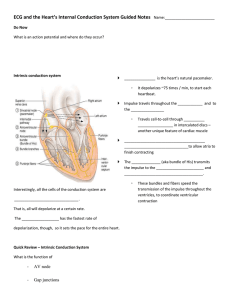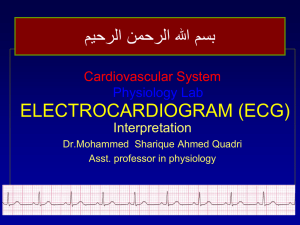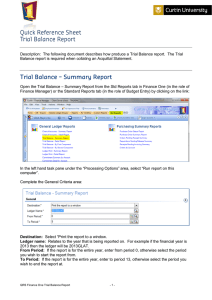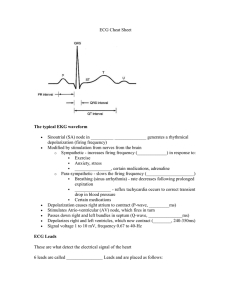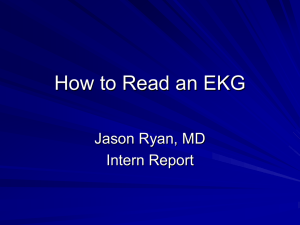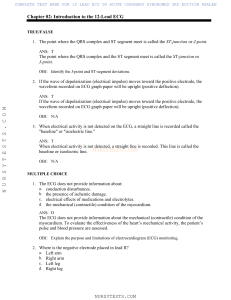ECG for Interns UCI Internal Medicine Mini-Lecture
advertisement
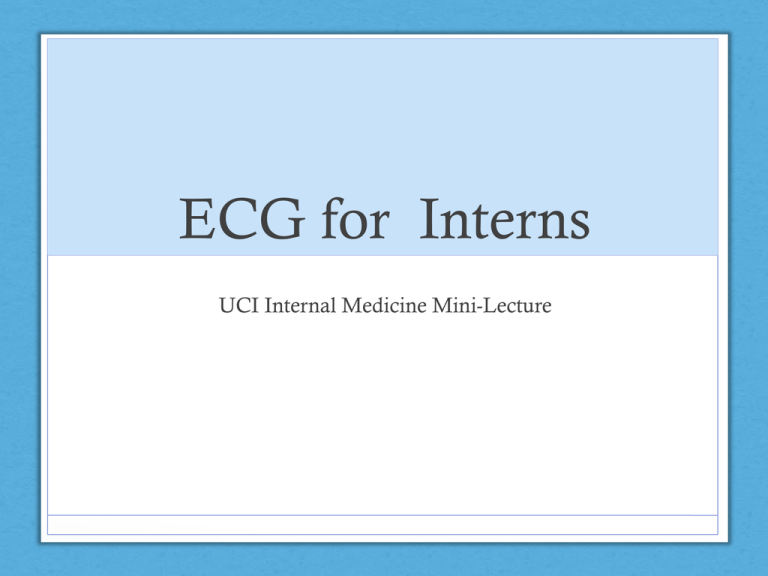
ECG for Interns UCI Internal Medicine Mini-Lecture Learning Objectives • Basics of EKG • Establish Consistent Approach to Interpreting ECGs • Rate, rhythm, axis, identifying ischemia • Review Essential Cases for New Interns • Provide Additional Resources for Future Learning Basics of EKG: Einthoven’s Triangle and Vectors +AVR Why is lead II often so important? ->you can see the heart’s depolarization vector is in the same axis as lead II! ->this means that in normal conduction, the QRS should be upright in lead II +AVL +AVF ECG Interpretation What is your approach to reading an ECG? •Rate •Rhythm •Axis •Hypertrophy •Intervals •P wave •QRS complex •ST segment – T wave Rate Square Counting: 300-150-100-75-60-50-42A Count QRS in 10 second rhythm strip x 6 use this method to determine rate when rhythm is irregular (e.g., atrial fibrillation) Rhythm Look at the rhythm strip below and answer the questions • Are P waves present? • yes • Is there a P wave before every QRS complex and a QRS complex after every P wave? • yes • Are the P waves and QRS complexes regular? • yes • Is the PR interval constant? • yes Yes to all these questions, so this is normal sinus rhythm! Axis •Axis is the general flow of electricity as it passes through the heart Look at the main direction of the QRS complex in leads I and AVF I AVF Axis + + normal + - LAD - + RAD QRS Duration • Normal QRS is < 120 ms • Prolonged QRS duration (>120ms) is seen in bundle branch blocks (BBB). • This is a result of abnormal conduction through the bundle branches or fascicles in the electrical conduction system • Different criteria for left and right bundle branch blocks but know the general morphology of each. Left and right bundle branch blocks Left BBB – • • Dominant S wave in V1 (‘W’-shaped) • Broad, notched (‘M’-shaped) R wave in V6 • Right BBB – • Tall R wave in V1 (‘M’-shaped) • Wide, slurred S wave (‘W’-shaped) in V6 QRS complex Poor R Wave Progression in V1 to V6: suggests prior anterior MI •Pathologic Q wave = previous MI. -Q wave amplitude 25% or more of the subsequent R wave OR - Q wave > 0.04 s in width + > 2 mm in amplitude in more than one lead Hypertrophy LVH: 2 commonly used criteria (use either) 1. Sokolow criteria: S in V1 or V2 + R in V5 or V6 ≥ 35 mm. 2. Cornell criteria: S in V3 + R in aVL > 28 mm (men) S in V3 + R in aVL > 20 mm (women) RVH: V1 R/S ratio >1 OR V6 S/R ratio >1 Intervals What is the normal PR interval? •0.12 to 0.20 s (3 - 5 small squares). •Short PR – Look for Wolff-Parkinson-White. •Long PR – 1st Degree AV block What is the normal QRS? •< 0.12 s duration (3 small squares). •Long QRS - look for bundle branch block, ventricular pre-excitation, ventricular pacing or ventricular tachycardia What is the normal QTc (QT/square root of RR)? •< 0.42 s. •Long QTc can lead to torsades to pointes. P Waves •Left atrial enlargement (P mitrale) = wide, bifid P wave: >0.12s in lead II or biphasic P in lead V1 with largely negative terminal portion •Right atrial enlargement (P pulmonale) = peaked P: amplitude >2.5mm in inferior leads (II, III, avF) or >1.5mm in V1, V2 •If multiple morphologies Wandering pacemaker or Multifocal atrial tachycardia (common in COPD) ST segment and MI ST elevation may indicate STEMI if the following are met: • At least 1 mm (0.1 mV) elevation in the limb leads (I, II, III, AVL, AVR) • At least 2 mm elevation in the precordial leads (V1-V6) • Elevation must be in at least 2 anatomically contiguous leads (see upcoming slides on “grouping leads”) ST depression may indicate NSTEMI if the following are met: • Downsloping ST depression ≥ 0.5 mm • Must be in at least 2 anatomically contiguous leads Evolution of an MI: Patterns on EKG First thing you should do when looking for ischemia: Group leads by region! EKG “Grouped Leads” correspond to area of injury LET’S DO SOME PRACTICE CASES Case #1 70 year old male with history of diabetes mellitus and hypertension occasionally feels lightheaded. He recently fainted while standing. Case #1 ECG Case #2 58 year old female with no significant past medical history presents with fatigue, lightheadedness and shortness of breath. Case #2 ECG Case #3 78 year old female with history of HTN, DM, HL, CAD admitted for syncope complains of palpitations and lightheadedness. Case #3 ECG Case #4 67 year old male with history of diabetes, hypertension, COPD presents with chest pain. Case #4 ECG Case #5 60 year-old man with history of HTN, HL, CAD presents with nausea, shortness of breath and chest pain. Case #5 ECG Additional Resources Websites: •http://en.ecgpedia.org/ •http://ecg.utah.edu •http://ecg.bidmc.harvard.edu/maven/ Apps: •ECG Guide by QxMD (iPad and iPhone) •ECG Interpret (iPhone) Books: •12-Lead ECG: The Art of Interpretation, Tomas Garcia (perhaps the best book on ECGs with detailed explanations and physiology.) •Arrhythmia Recognition, Tomas Garcia Summary • Learned the basics of EKG • Learned how to have a consistent approach to EKGs • Reviewed essential cases for new interns • Equipped with resources for continued learning

